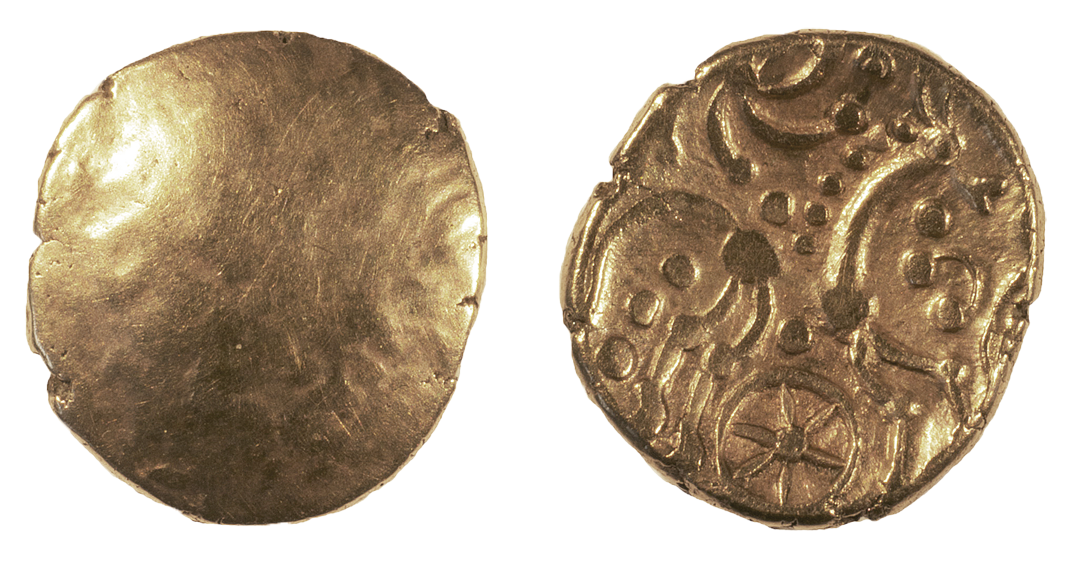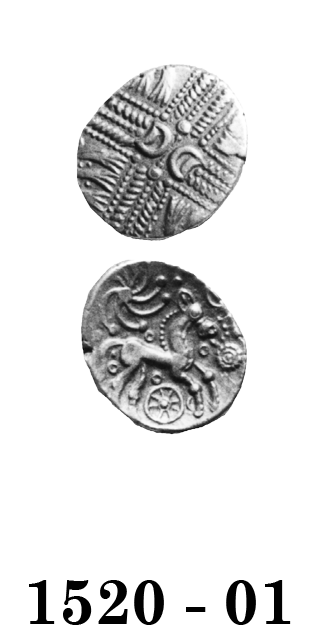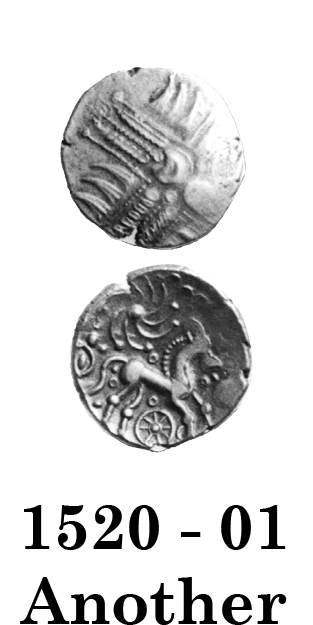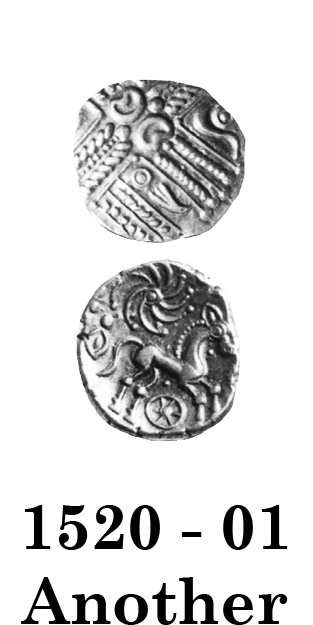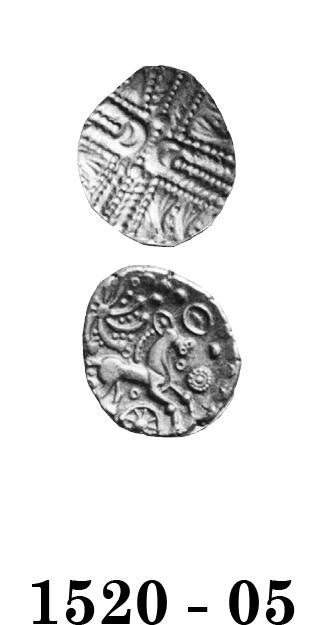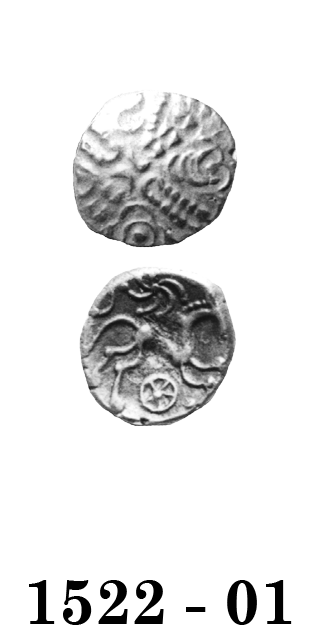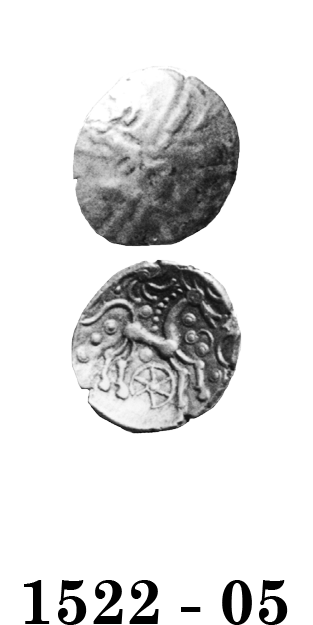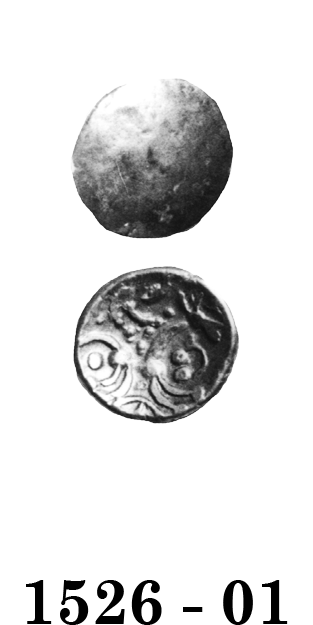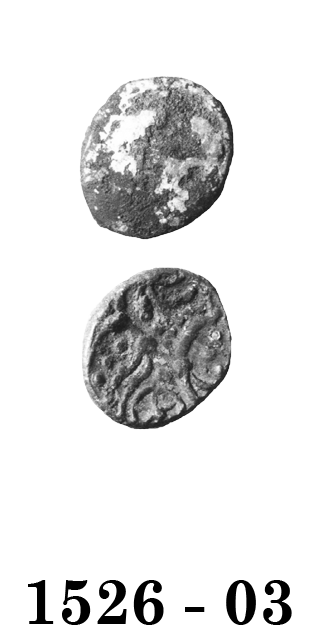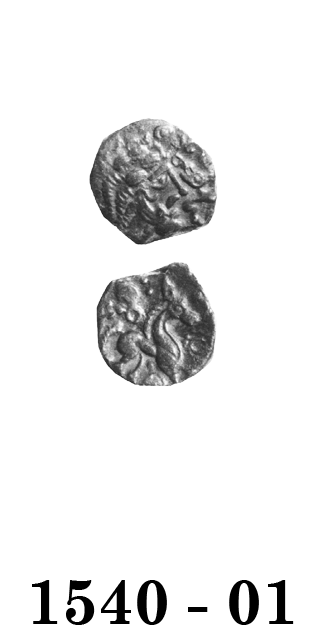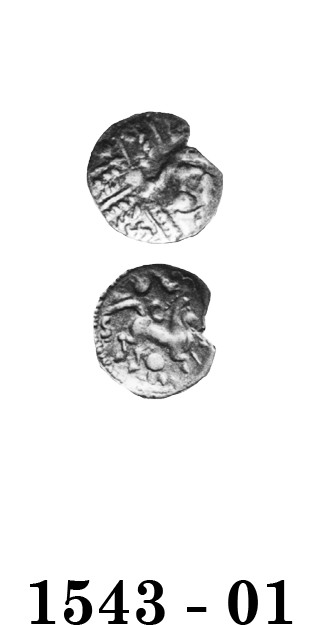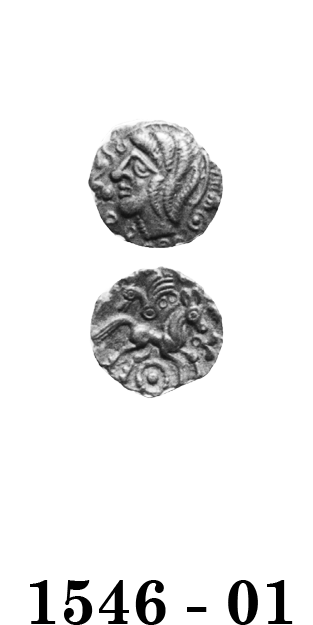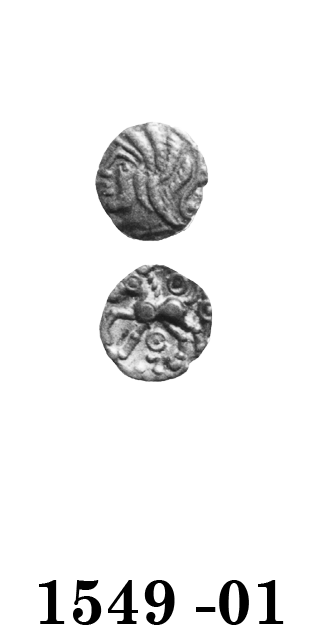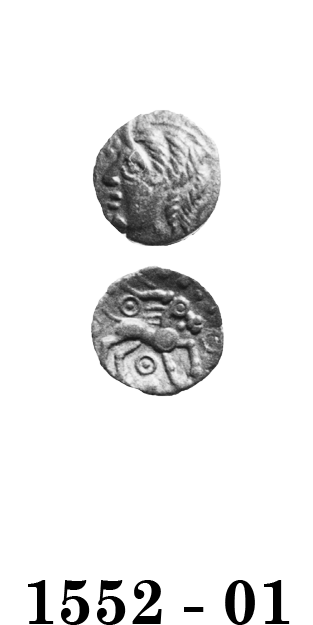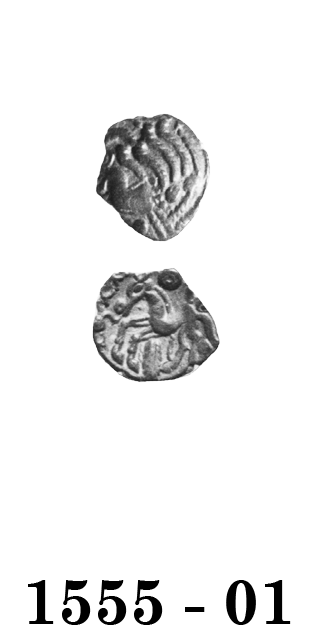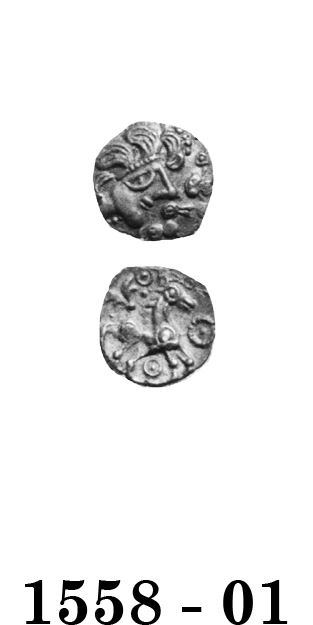
Celtic Coinage of Britain
third edition
Click on coin to see hidden information
Later Trinovantian/Catuvellaunian Uninscribed Gold and Silver Coins
As the images on the Whaddon Chase Types are revised and modified over time, a series of silver types is introduced. Some of these have images similar to those on the gold coins.
Two additional gold types are struck, the WONERSH and SAVERNAKE FOREST types. These are problematic, and are difficult to relate to the Whaddon Chase series. Possibly they were struck by a different tribe, or were coins used for some special purpose.
Coins Deleted from Catalogue
Several coins catalogued in the third edition of Mack's Coinage of Ancient Britain have been deleted from this section. M280 is probably a Gaulish type with its long-legged horse; M280a, of which no photograph is available; M280b, probably Gaulish, with a boar above the horse; M280c, a bronze minim—not known to be a British denomination; M280d, a known Gaulish type from the excavations at Fanum de Chilly, number 48; M396a, similar to 1558 - 01, but has a long-legged horse and is thus probably Gaulish; M445a, of which no photo is available; M445b, which is too worn to attribute; and M445c, which, with a long-legged boar, is probably Gaulish.
Wonersh Type
The following WONERSH TYPE is similar in style to some of the Middle Whaddon Chase staters. Lighter than the standard weight for the period, it is often found outside the normal tribal area. It may be a coin used for external trade, or may be a copy produced by a different tribe.
Savernake Forest Type
The following SAVERNAKE FOREST TYPES appear to have reverses derived from the Wonersh Type. They are believed to post-date the Wonersh Types because they are often encountered struck in a very base metal, or plated.
Uninscribed Silver Coins of the Trinovantes/Catuvellauni
The first silver coins were struck about the middle of the Gallic War.
It is anticipated additional varieties will be discovered in the coming years as a result of the use of metal-detectors.
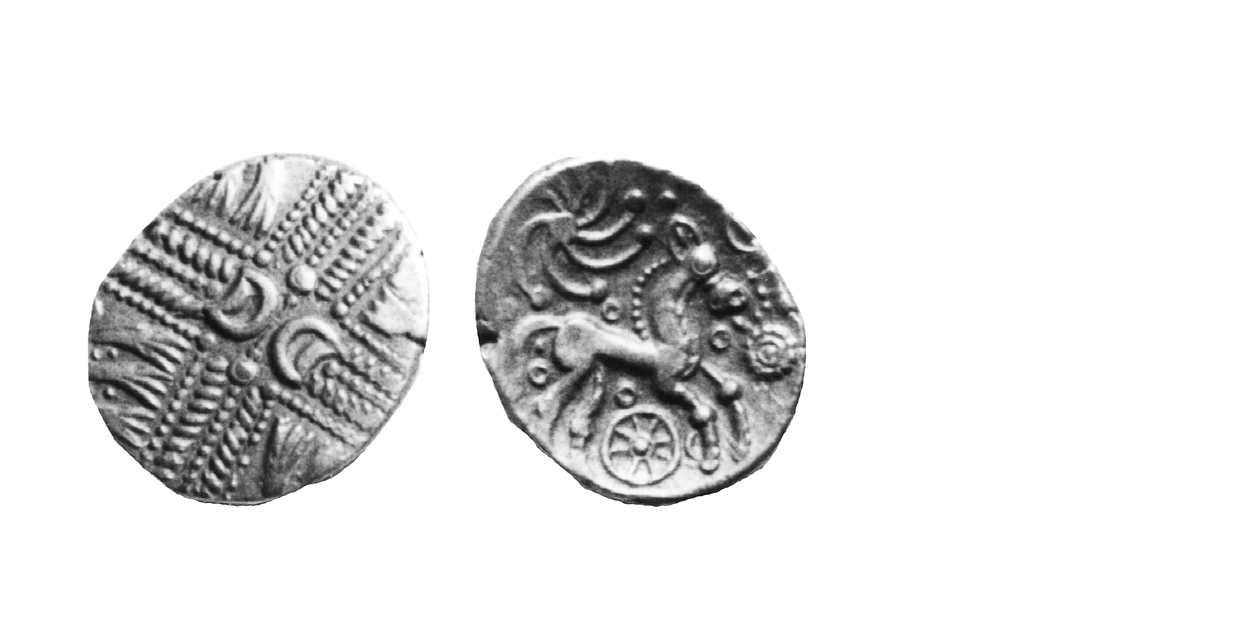
1520 - 01 Wonersh Type
45-40 B.C. Very Rare
Gold Stater ca. 5.4-5.3 gms. 19 mm
Earliest Record: Evans, 1864
OBV: Abstracted head of Apollo right
Identifying points:
1) wreath now forms "X" pattern
2) two outline crescents back-to-back in centre
3) no spike
REV: Romanized horse right
Identifying points:
1) eight-spoked wheel with axle below horse
2) eight-armed spiral above horse
3) horse's ear shaped like an ellipse, as on Whaddon Chase staters
4) small rings in field around horse
5) anemone in front of horse
CLASSIFICATION: Trinovantian G
NOTES:
- Typical weight given
- Celtic Coin Index records now indicate commoner than previously thought
- Some varieties have a six-spoked wheel
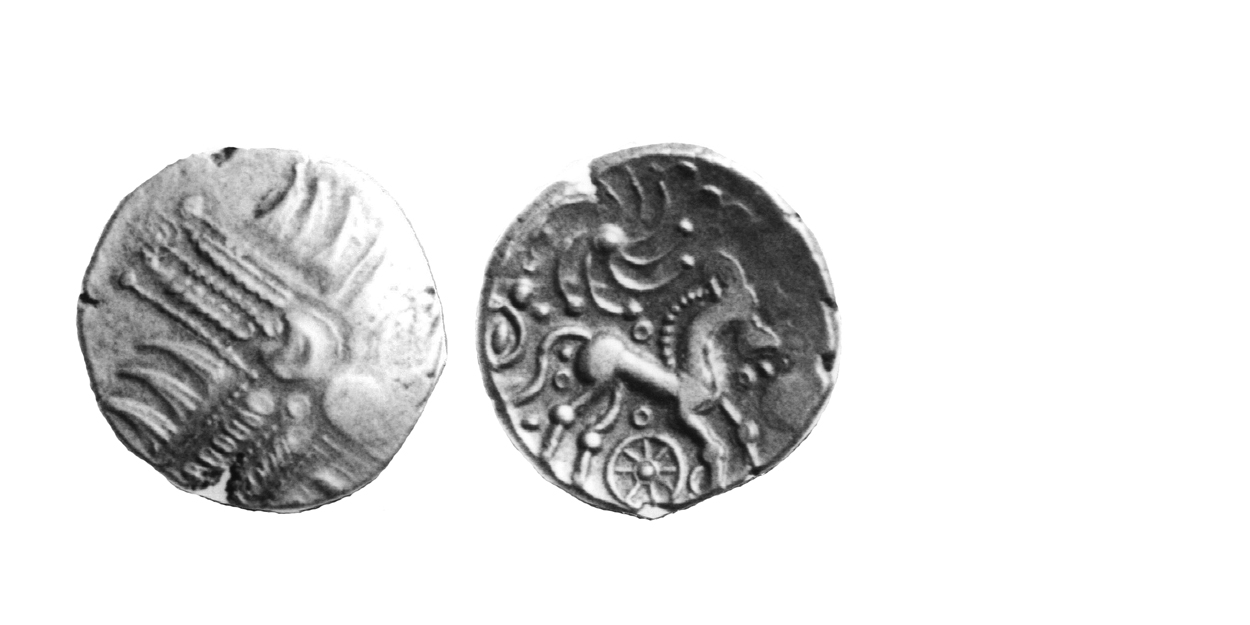
1520 - 01 Wonersh Type
45-40 B.C. Very Rare
Gold Stater ca. 5.4-5.3 gms. 19 mm
Earliest Record: Evans, 1864
OBV: Abstracted head of Apollo right
Identifying points:
1) wreath now forms "X" pattern
2) two outline crescents back-to-back in centre
3) no spike
REV: Romanized horse right
Identifying points:
1) eight-spoked wheel with axle below horse
2) eight-armed spiral above horse
3) horse's ear shaped like an ellipse, as on Whaddon Chase staters
4) small rings in field around horse
5) anemone in front of horse
CLASSIFICATION: Trinovantian G
NOTES:
- Typical weight given
- Celtic Coin Index records now indicate commoner than previously thought
- Some varieties have a six-spoked wheel
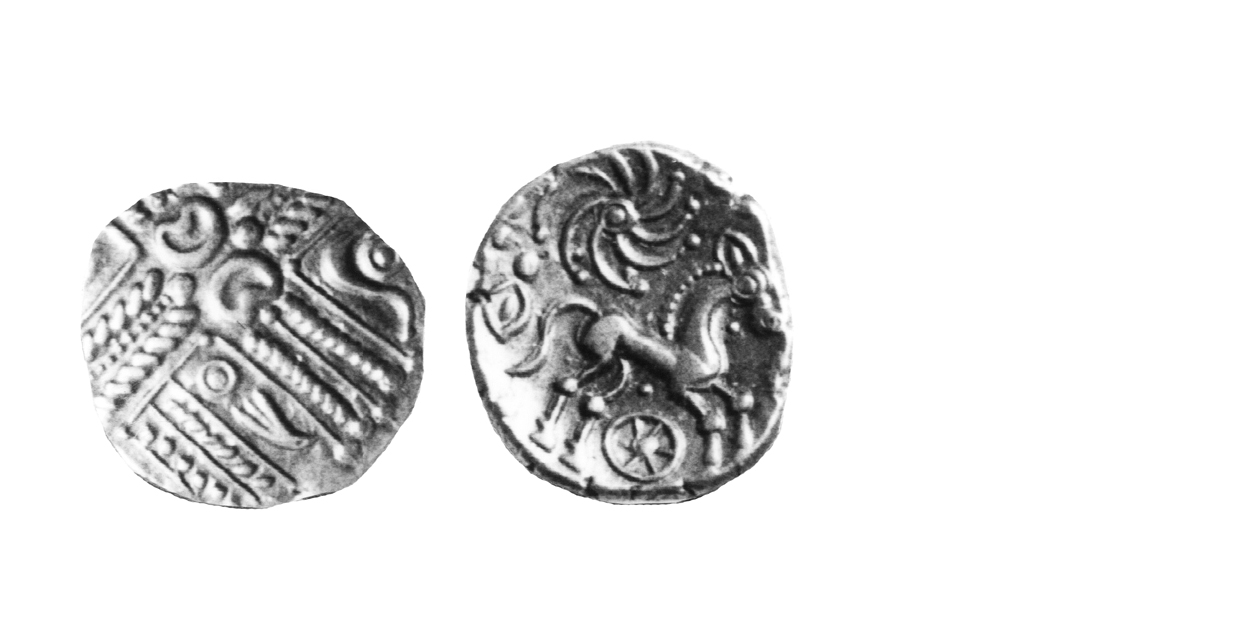
1520 - 01 Wonersh Type
45-40 B.C. Very Rare
Gold Stater ca. 5.4-5.3 gms. 19 mm
Earliest Record: Evans, 1864
OBV: Abstracted head of Apollo right
Identifying points:
1) wreath now forms "X" pattern
2) two outline crescents back-to-back in centre
3) no spike
REV: Romanized horse right
Identifying points:
1) eight-spoked wheel with axle below horse
2) eight-armed spiral above horse
3) horse's ear shaped like an ellipse, as on Whaddon Chase staters
4) small rings in field around horse
5) anemone in front of horse
CLASSIFICATION: Trinovantian G
NOTES:
- Typical weight given
- Celtic Coin Index records now indicate commoner than previously thought
- Some varieties have a six-spoked wheel
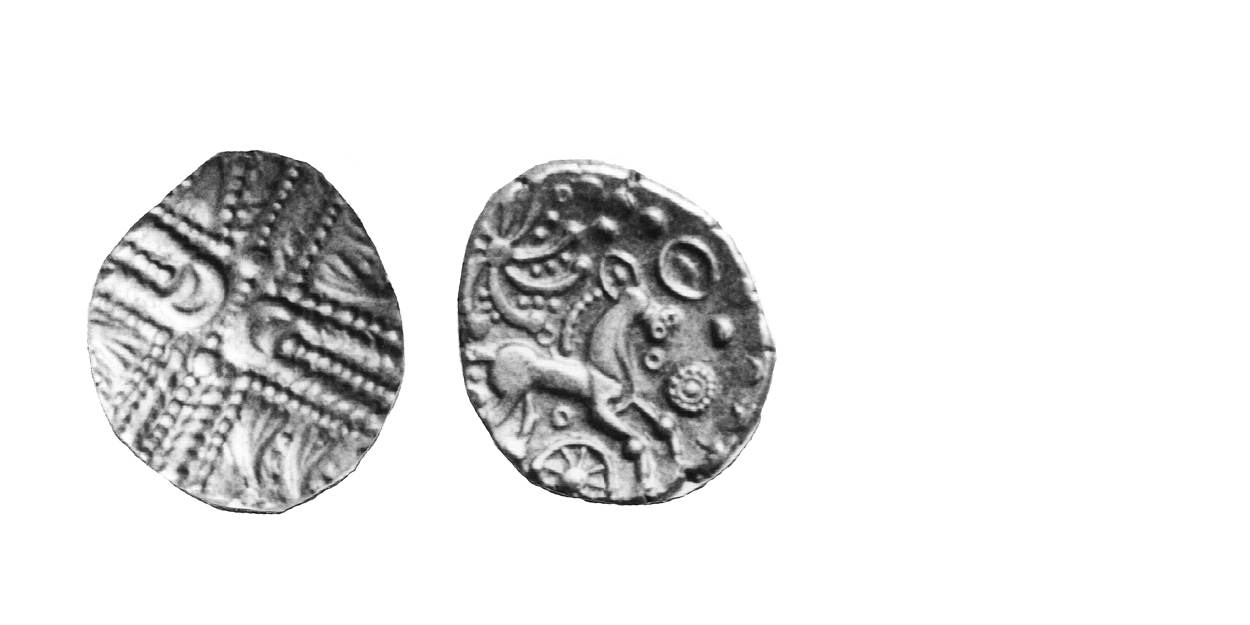
1520 - 05 Wonersh Type
45-40 B.C. Extremely Rare
Gold Stater 18 mm
Earliest Record: Van Arsdell, 1989
OBV: Abstracted head of Apollo right
Identifying points:
1) wreath now forms "X" pattern
2) two outline crescents back-to-back in centre
3) no spike
REV: Romanized horse right
Identifying points:
1) eight-spoked wheel with axle below horse
2) eight-armed spiral above horse
3) horse's ear shaped like an ellipse, as on Whaddon Chase staters
4) small rings in field around horse
5) anemone in front of horse
6) rows of pellets between arms of spiral
CLASSIFICATION: Trinovantian G
NOTES:
- Most are in museums
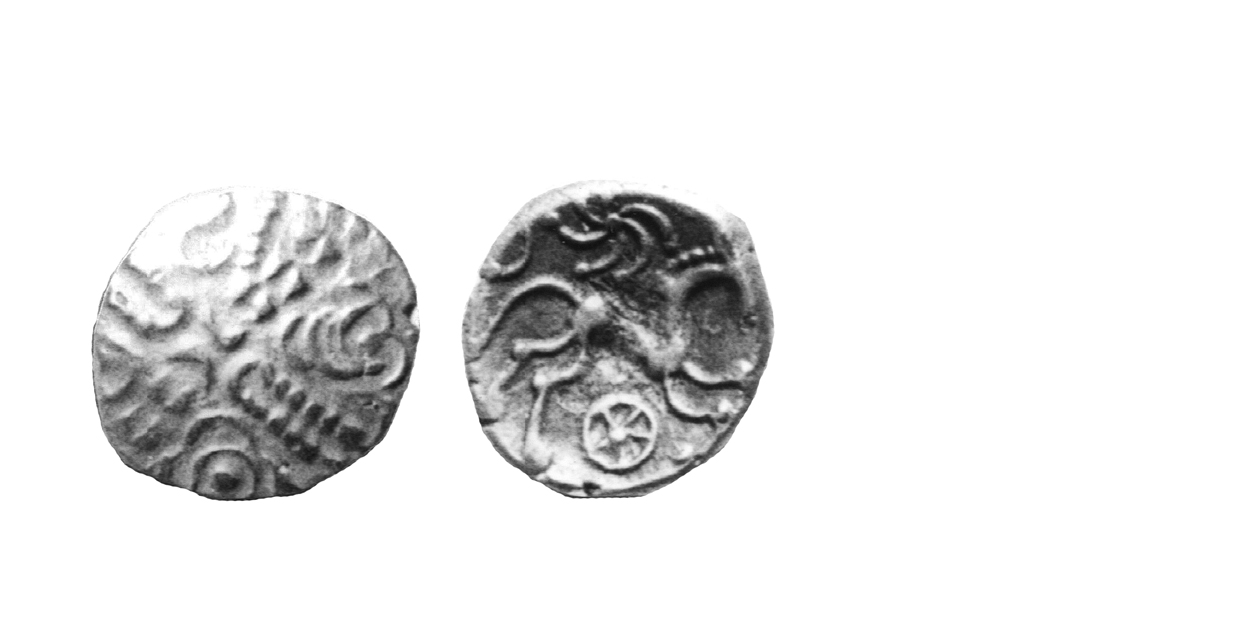
1522 - 01 Wonersh Type
45-40 B.C. Extremely Rare
Gold Stater ca. 5.4 5.2 gms. 16 mm
Earliest Record: Evans, 1864
OBV: Abstracted head of Apollo right
Identifying points:
1) wreath now forms "X" pattern
2) two outline crescents back-to-back in centre
3) no spike
REV: Celticized horse right
Identifying points:
1) five-spoked wheel below horse
2) six-armed spiral above horse
3) horse's tail made up of a single line
CLASSIFICATION: Trinovantian G
NOTES:
- Previously, this type was thought to be a link between the Whaddon Chase Type and the Wonersh Type. However, stylistically it is a link between the Wonersh and Savernake Forest Types.
- Typical weight given
- Celtic Coin Index records now indicate rarer than previously thought
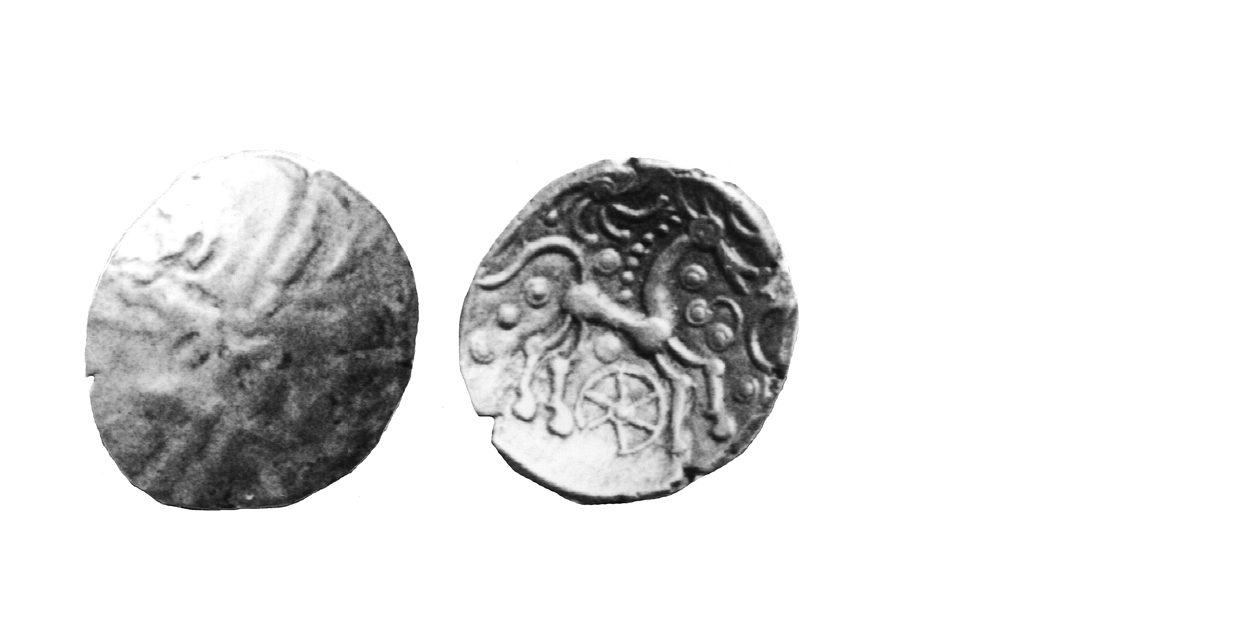
1522 - 05 Wonersh Type
45-40 B.C. Extremely Rare
Gold Stater 18 mm
Earliest Record: Van Arsdell, 1989
OBV: Almost plain
Identifying points:
1) obverse die almost obliterated
REV: Celticized horse right
Identifying points:
1) similar to 1522 - 01
2) arms of spiral turn in opposite direction, compared to 1522 - 01
3) six-spoked wheel with axle below horse
4) pellet-in-ring motif in field
CLASSIFICATION: Trinovantian G
NOTES:
- Most are in museums
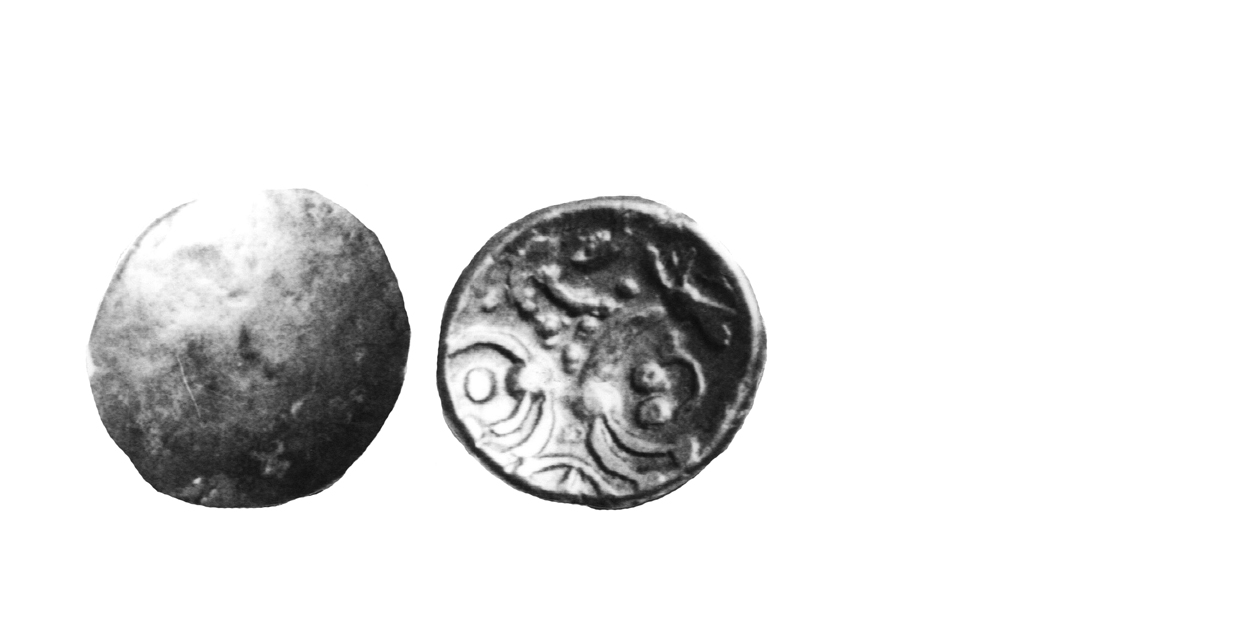
1526 - 01 Savernake Forest Type
ca. 40 B.C. Scarce
Base Gold Stater ca. 4.8 gms. 16 mm
Earliest Record: Evans, 1864
OBV: Plain, or almost plain
Identifying points:
1) faint signs of abstracted head of Apollo may appear
REV: Highly stylized Celtic horse right
Identifying points:
1) horse made up of three large pellets and curved lines
2) large wheel below horse
3) large spiral above horse
CLASSIFICATION: Trinovantian H
NOTES:
- Typical weight given
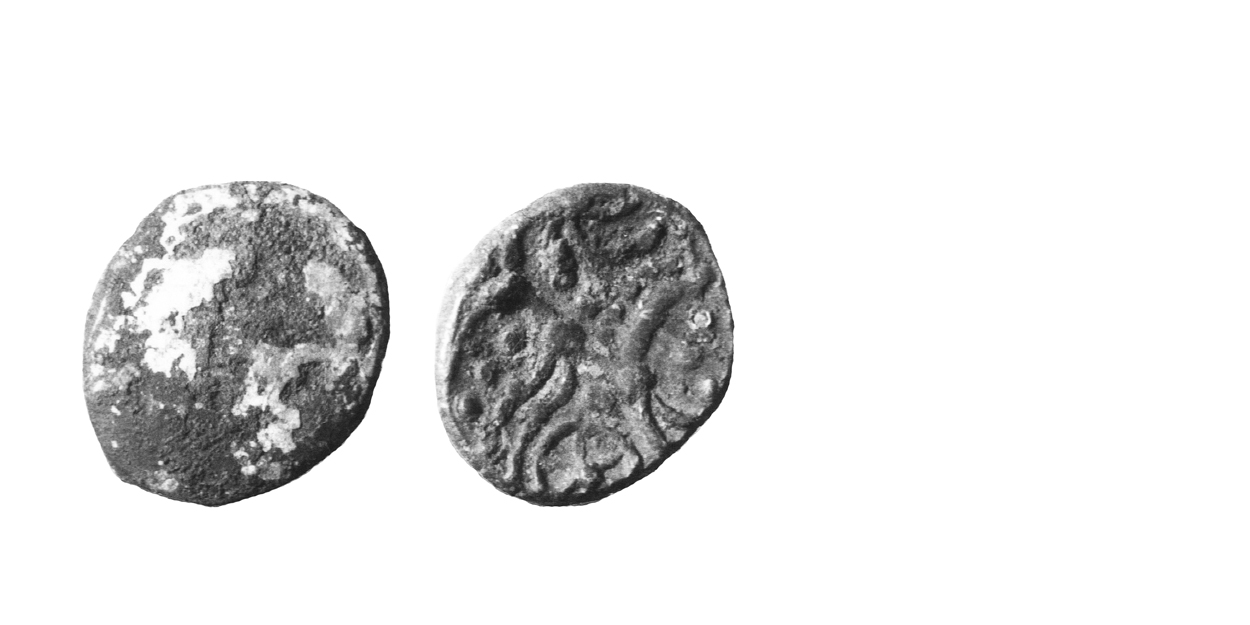
1526 - 03 Savernake Forest Type
ca. 40 B.C. Very Rare
Gold/Bronze Plated Stater ca. 3.2 gms. 17 mm
Earliest record: Van Arsdell, 1989
OBV: Plain
REV: Highly stylized Celtic horse right
Identifying points:
1) horse made up of three large pellets and curved lines
2) large wheel below horse
3) large spiral above horse
CLASSIFICATION: Trinovantian H
NOTES:
- Bronze core of plated gold stater of 1526 - 01
- Possibly struck from official dies
- Typical weight given
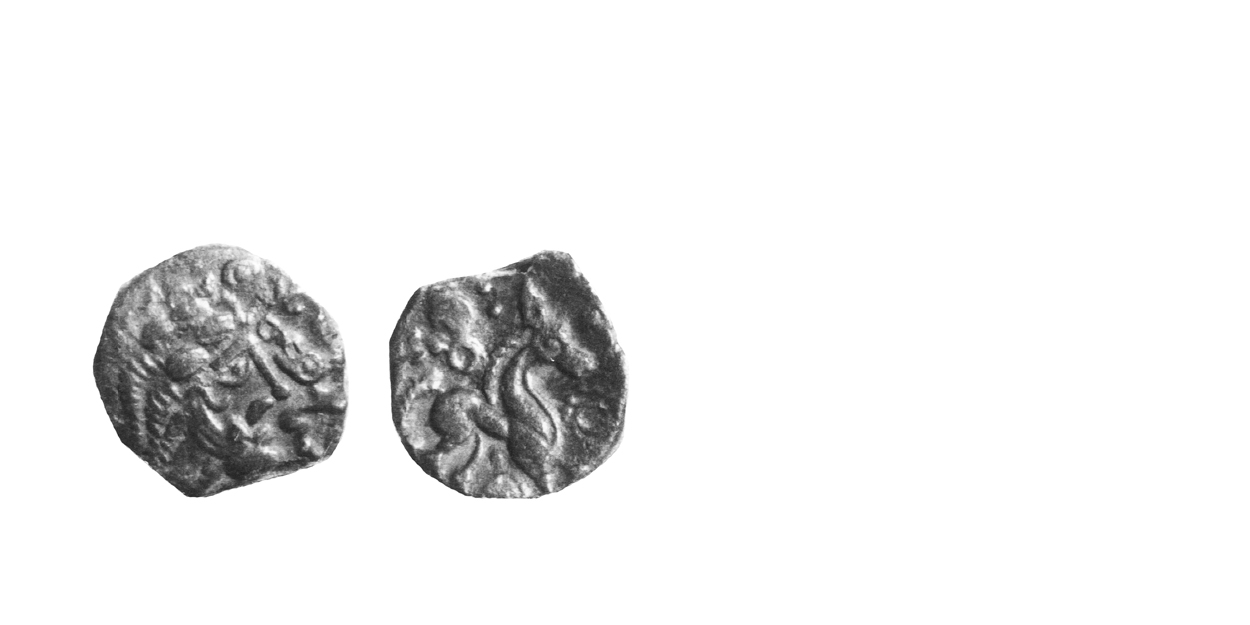
1540 - 01 Whaddon Chase Type
55-45 B.C. Extremely Rare
Silver Unit 1.2 gms. 15 mm
Earliest Record: Allen, 1960
OBV: Celticized head right
Identifying points:
1) pointed nose
2) hair formed by large pellets
REV: Celticized horse right
Identifying points:
1) elliptical ear on horse
2) winged object above horse
3) large pellet-in-ring motif below horse
4) ring with pellet-circle around in front of horse
CLASSIFICATION: Trinovantian D
NOTES:
- Typical weight given
- This coin is the Silver Unit corresponding to 1476 - 03
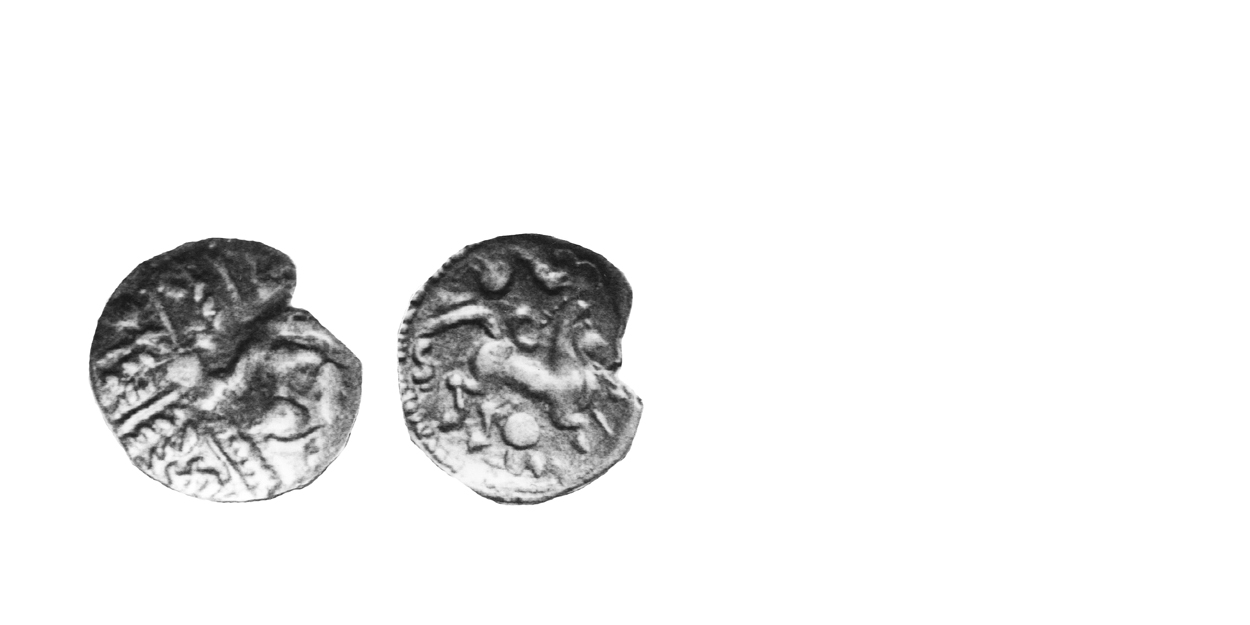
1543 - 01 Whaddon Chase Type
55-45 B.C. Extremely Rare
Silver Unit 14 mm
Earliest Record: Mack, 1953
OBV: Degraded Wreath of Apollo
Identifying points:
1) "spike" made up of lines and pellets
2) laurel leaves downwards
REV: Celticized horse right
Identifying points:
1) winged object above horse
2) large pellet below horse
CLASSIFICATION: Trinovantian D
NOTES:
- Most are in museums
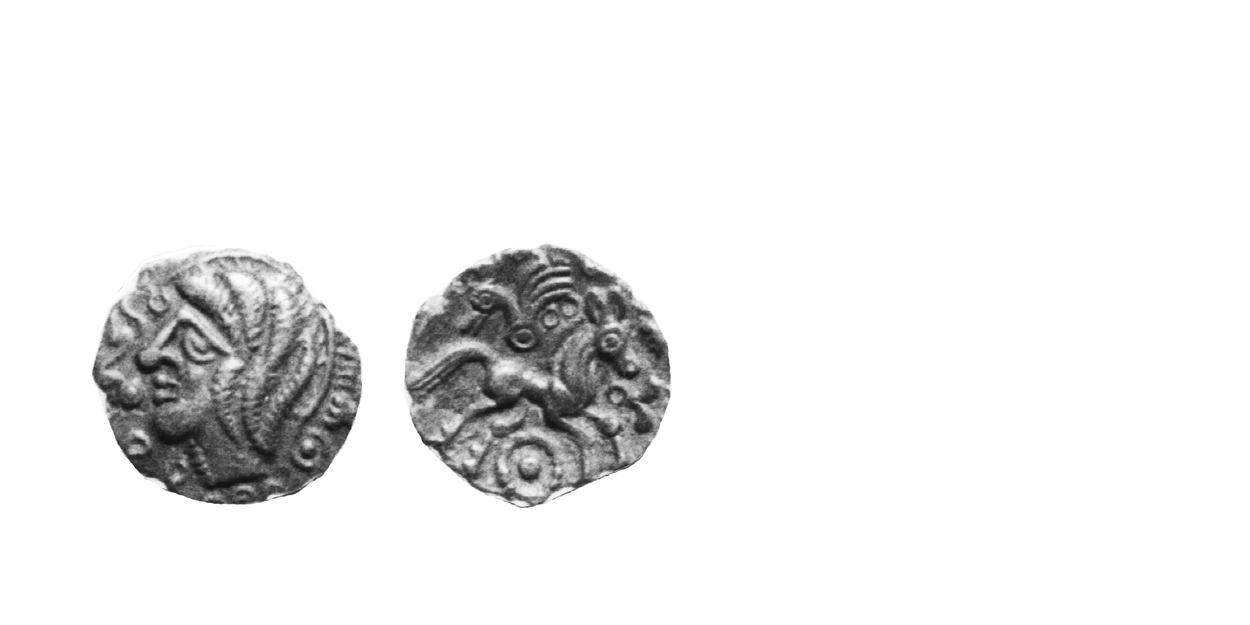
1546 - 01 Middle Whaddon Chase Type
45-40 B.C. Extremely Rare
Silver Unit 1.2 gms. 13 mm
Earliest Record: Evans, 1864
OBV: Celticized head left
Identifying points:
1) semicircle for eye
2) pellet-in-ring motif behind head
3) coiled hair
4) pellet-in-ring motif in front of mouth
5) small ring below head
REV: Celticized horse right
Identifying points:
1) horse has elliptical ear
2) bird above horse
3) pellet-in-ring motif below horse
CLASSIFICATION: Trinovantian E
NOTES:
- Most are in museums
- Typical weight given
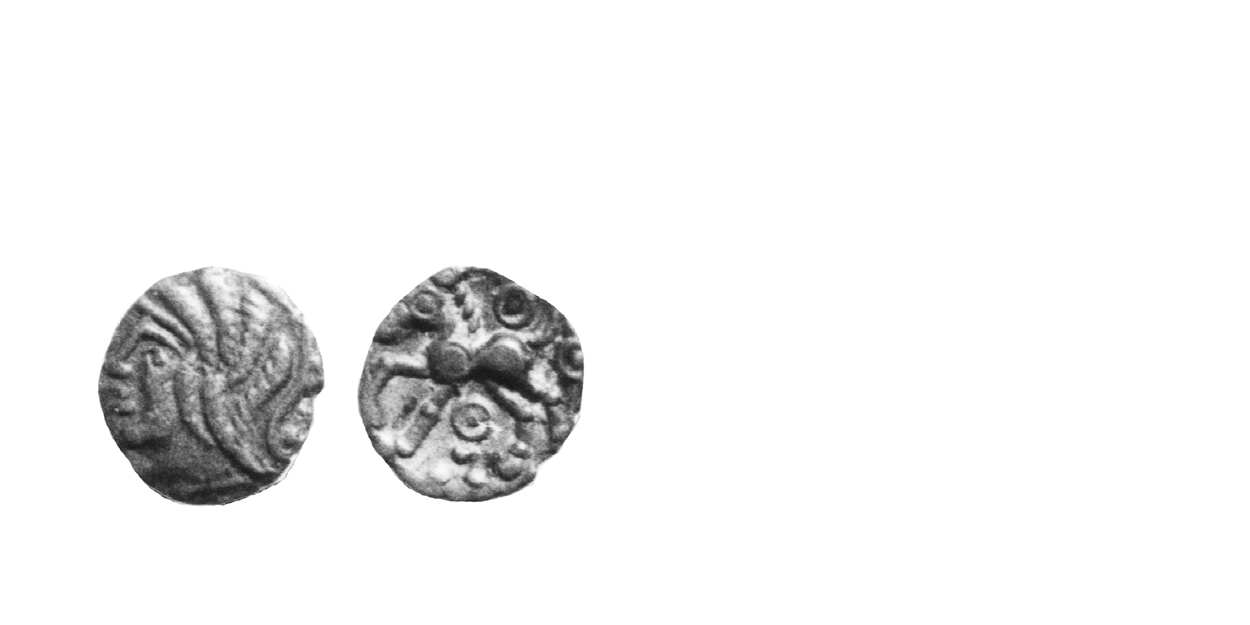
1549 - 01 Middle Whaddon Chase Type
45-40 B.C. Extremely Rare
Silver Unit 1.0 gm 12 mm
Earliest Record: Evans, 1864
OBV: Celticized head right
Identifying points:
1) similar to 1546 - 01
2) pellet for eye
REV: Celticized horse left
Identifying points:
1) pellet-in-ring motif for eye
2) pellet-in-ring motif above and below horse
3) three pellets below horse
CLASSIFICATION: Trinovantian E
NOTES:
- Most are in museums
- Typical weight given
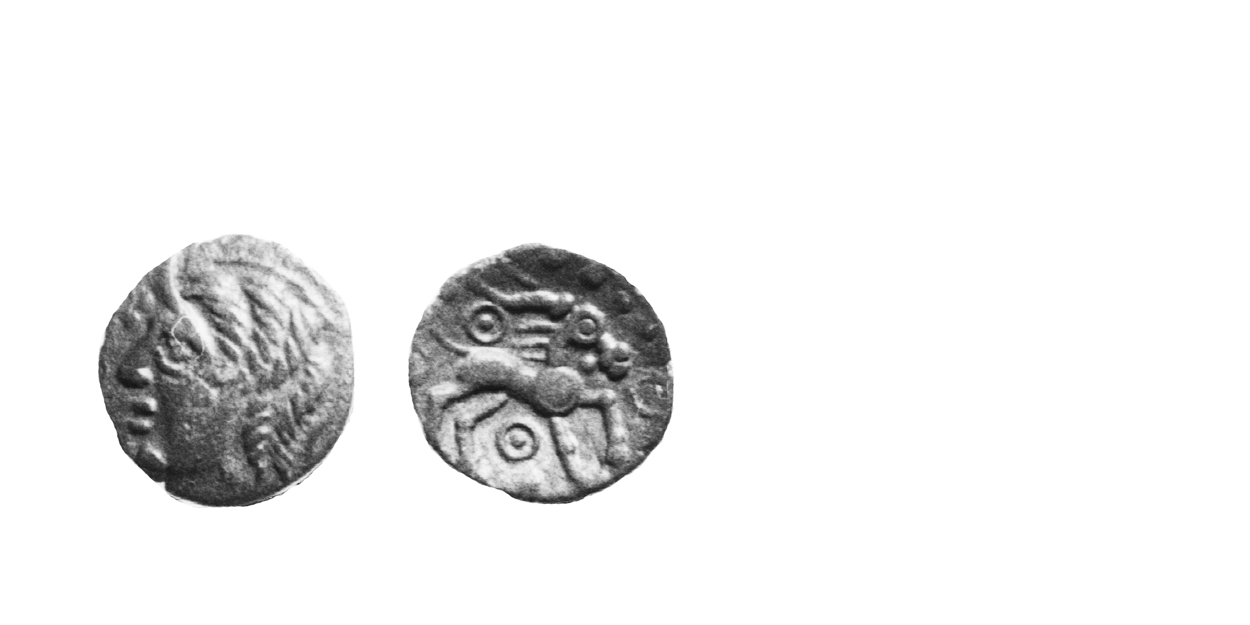
1552 - 01 Middle Whaddon Chase Type
45-40 B.C. Rare
Silver Unit 1.0 gm 13 mm
Earliest Record: Evans, 1864
OBV: Celticized head left
Identifying points:
1) similar to 1546 - 01
2) large pellet for eye
REV: Celticized stag right
Identifying points:
1) pellet-in-ring motif above and below stag
2) pellet-in-ring motif for eye
3) pellet below head
CLASSIFICATION: Trinovantian E
NOTES:
- Some are in museums
- Celtic Coin index records now indicate commoner than previously thought
- Typical weight given
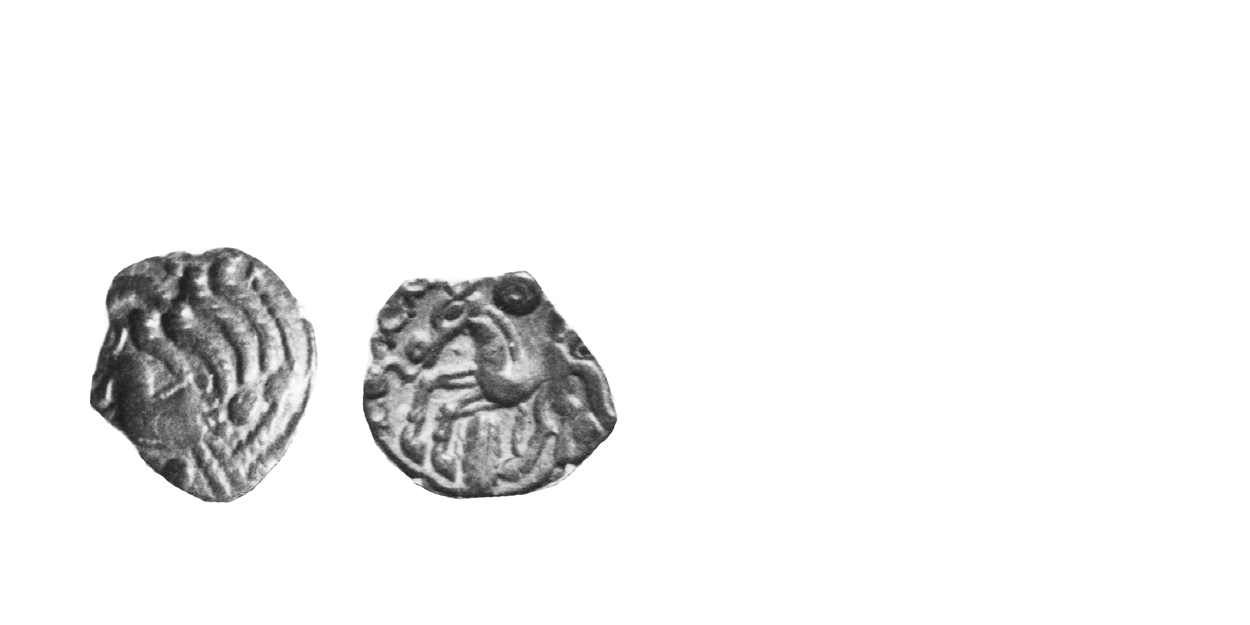
1555 - 01 Late Whaddon Chase Type
45-40 B.C. Extremely Rare
Silver Unit 0.9 gms. 13 mm
Earliest Record: Evans, 1864
OBV: Degraded head left
Identifying points:
1) coiled hair
2) similar to 1546 - 01, but image is degraded
REV: Celticized horse left
Identifying points:
1) pellet below head
2) ellipse for eye
3) front forelegs made up of two lines
4) two concentric rings above horse
5) feather-like object below horse
CLASSIFICATION: Trinovantian F
NOTES:
- Most are in museums
- Typical weight given
- Obverse apparently illustrated inverted in Evans and Mack
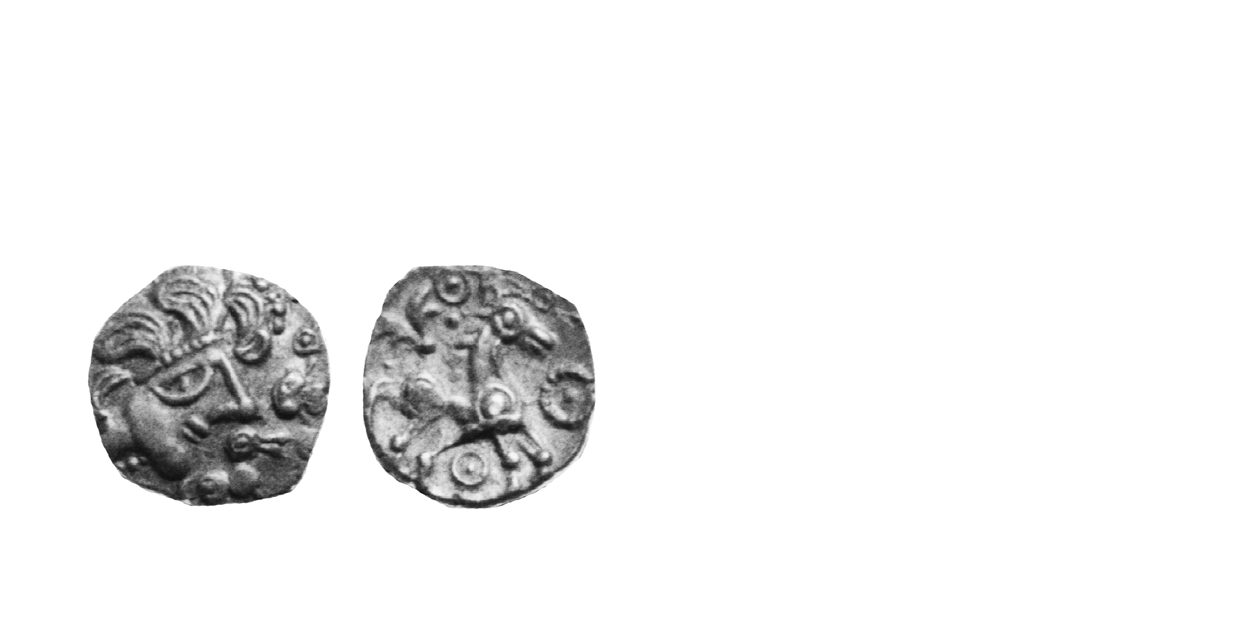
1558 - 01 Late Whaddon Chase Type
45-40 B.C. Very Rare
Silver Unit 1.26 gms. 13 mm
Earliest Record: Evans, 1890
OBV: Celticized head right
Identifying points:
1) pellet-in-semicircle for eye
2) birds or animals in front of head
3) four groups of curves for hair
REV: Celticized horse left
Identifying points:
1) pellet-in-ring motif above and below horse and in front of horse's head
2) floral pattern above horse (degraded bird from 1546 - 01)
3) sunflower in front of horse's head
CLASSIFICATION: Trinovantian F
NOTES:
- Typical weight given
- Celtic Coin Index records now indicate commoner than previously thought
Coinage of the Trinovantes/Catuvellauni
Traditionally, the Trinovantes and Catuvellauni were considered distinct tribes, each with its own coinage. An elaborate history, written from the coin inscriptions, described a long intertribal warfare. The Trinovantes received blow after devastating blow from the warlike Catuvellauni and lost Camulodunum, their tribal capital, several times in the process. The evidence was founded partially on Caesar's writings – the ruler of the Trinovantes had been killed by Cassivellaunus. Cassivellaunus was assumed to be a ruler of the Catuvellauni, though Caesar never stated so. The rest of the support came from an analysis of the findspots of the Dynastic coins.
Today, this history is considered a myth – the coin evidence no longer supports continual internecine warfare north of the Thames. Cassivellaunus' tribal origin is not mentioned by any contemporary writer and there is no indication he was the ruler of the Catuvellauni. The similarity of the tribal and personal names is coincidence, not a link between the two. Furthermore, recent analyses of the findspot distributions indicate the coins circulated farther afield than previously thought. The territory north of the Thames can no longer be separated into two distinct coin-using zones.
Instead, the coinage is seen today as that of a single economic group – coin types appear in succession and circulate not only throughout the area immediately north of the Thames, but into Icenian and Cantian territory as well. Metrology and typology show the inscriptions on the dynastic issues are those of successive rulers, not contemporary adversaries.
In general, the picture today is of a powerful, united tribe occupying the area north of the Thames. The unification must have occurred shortly before the Gallic War, or during it. This unified tribe had economic influence beyond its borders which increased throughout the period of the coinage. The tribal group ultimately controlled the economy of the Cantii, and to a lesser extent the economies of the Iceni and Atrebates/Regni/Belgae.
But what was this group group?
That two tribes existed is not in doubt. Caesar mentions the Trinovantes in his Gallic War commentaries, stating they were probably the most powerful tribe in southern Britain. The Catuvellauni are mentioned on an inscribed Roman stone from Hadrian's wall. There were two minting centres in the territory, at the tribal oppida of Verulamium and Camulodunum, suggesting two political centres existed. However, the coinage is a unified one since the two tribal groups must have merged into a single economic unit before they started producing coins. As a result, the tribes cannot be distinguished numismatically, and they are referred to as the Trinovantes/Catuvellauni. For all practical purposes, by the introduction of the Whaddon Chase Type about 55 B.C., they had come to act as one economically, and perhaps had been doing so as early as 125 B.C. The inscribed coinage argues for political unity by 40 B.C. as well. The dynastic coins show an orderly succession of rulers, except for a brief period around the turn of the millenium. This appears to have been an Interregnum, during which the succession was disputed.
The Trinovantes/Catuvellauni occupied the entire territory immediately north of the Thames. They were bounded on the north-east by the Iceni, on the south by the Cantii and Atrebates/Regni/Belgae, on the north the by the Corieltauvi, and on the west, probably, by the Dobunni. Thus, they were in physical contact with all the tribes of the south-east, and in a position to exert influence.
By 125 B.C.. they were importing coins from the Ambiani on the Continent, and shared the cross-Channel trade with the Cantii and Atrebates/Regni. Large Flan, Defaced Die and Abstract Type gold coins are found throughout their territory in quantity.
When the Cantii began casting bronze coins about 100 B.C., the Trinovantes/Catuvellauni followed this lead and produced their own cast coinage for a brief period. In the early 1980s a small hoard of unusual cast bronze coins was dispersed in Europe, about 100 to 300 pieces with an alleged 'Folkestone findspot'. At first this was dismissed as incorrect, and the coins branded Gaulish. However, during the late summer of 1987 a hoard of about 2,000 cast bronzes, including the unusual type, were found in a pit in the vicinity of West Thurrock, Essex. The coins occurred in at least sixteen varieties, with a reasonable typological progression. One coin had a large protrusion of flash which would have broken off had the coin been moved any great distance. In general, the hoard appeared to be made up of coins collected by a mint, perhaps for remelting. No other evidence of minting activity was noted at the site, but it appears the mint cannot have been far away.
THURROCK TYPE cast bronzes are also found as single finds in Essex. A few have been found in the Thames River and one coin was found in Dorset. Many single finds and one small hoard have been found in Kent, prompting some to the conclusion they are a Kentish issue. The coins cannot have been used for a very long time. Three interpretations are likely: 1) they have a Gaulish origin and were briefly imported, 2) they have a British origin and represent the first coinage of the Trinovantes/Catuvellauni, or 3) they are a Kentish issue. Although similar coins are reported from the Continent (Castelin, 1978, numbers 477 to 485), they are not sufficiently alike to have a common Gaulish origin. Thus, of the three interpretations, the Gaulish origin appears the least likely. The Thurrock Hoard, representing a complete corpus of the series, would have been very difficult to assemble outside the mint – it very well may be a hoard of mint scrap. Thus, the suggestion here is that the Thurrock Hoard was produced in the vicinity of the findspot – the coins representing a Trinovantian/Catuvellaunian issue.
Thurrock Types appear to have been influenced by the Prototype Period cast bronzes of the Cantii, dating them about l00 to 90 B.C. Within twenty years, the tribe was striking its own gold coinage.
The Trinovantes/Catuvellauni were one of the earliest tribes to begin striking gold staters, with the introduction of the CLACTON and NORTHERN WESTERHAM TYPES around 70-60 B.C. A hoard of the CLACTON TYPES was found with Ambiani Abstract Type staters at Clacton beach. This type, like all the early types struck in Britain was, short-lived – submerged by the large influx of Gallic War staters. About the middle of the war, the tribe began to strike the WHADDON CHASE TYPE, and continued to produce coins until the Claudian invasion a hundred years later.
The Trinovantes/Catuvellauni apparently collaborated with the Romans during the War. They probably did this by hampering trade between the Durotriges and the Armorican tribes, by competing for supplies within Britain. They may have delivered supplies directly to the Roman army, as well. The tribe obtained a large amount of gold for this effort and evidently became the recipient of wine-trading rights with the Romans. This favour ultimately gave the tribe an economic superiority over all the other tribes in the southeast after the war.
The tribe operated two mints, one at Verulamium, the other at Camulodunum. Initially, the Verulamium mint produced most of the coins, but it was overshadowed by Camulodunum in the first century A.D. The remains of both mints have been found during archaeological excavations.
It has long been asserted that Caesar gave coin-manufacturing assistance during his visit in 54 B.C., because the coins of the period display Romanizing influences. Training was probably unnecessary, however, because the moneyers would have been expert metal-workers already. The die-cutting on Whaddon Chase staters is excellent, but surprisingly, the dies were cut in soft metal. They broke up quickly and many of the existing pieces show die-damage. Sometimes depressions appear where the die surface heaved up during punching. Normally, the heaved surfaces would have been planed off, but this was not done for some reason. All this suggests that the minting was hurried, not unusual for a time of war.
The Trinovantes/Catuvellauni continued to produce coins after the War, and there appears to be little reduction in the amount produced. A silver coinage started either during the War or just after. Shortly after Commius placed his name on the Atrebatic/Regnan/Belgic coinage, the tribe began its own dynastic series, probably around 40 B.C. By this time the tribe was producing bronze coins for small change, as well as gold and silver. The series of inscribed coins gives the names of the successive tribal leaders for the next eighty years.
